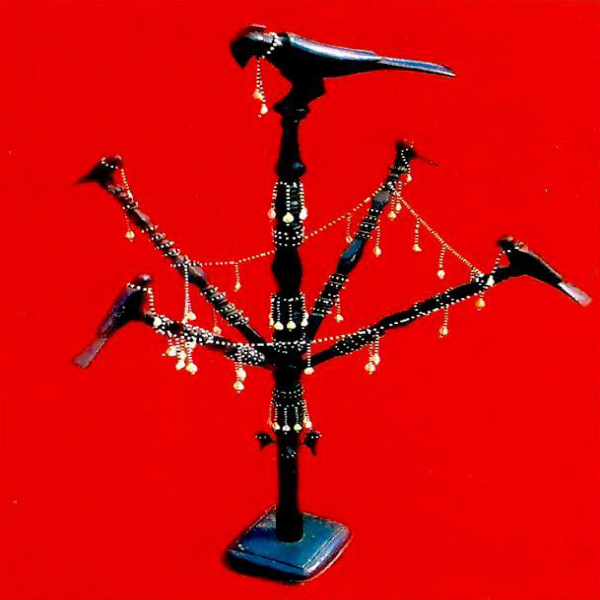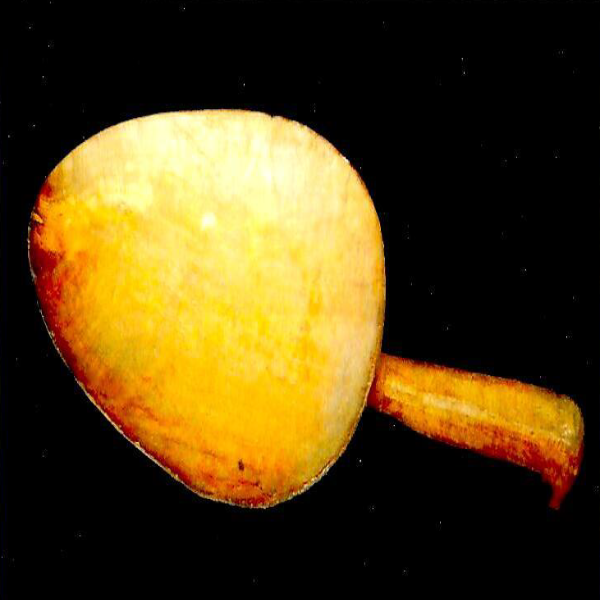State
Tribe Name
Art Type
short description
The Jambeli Athon is one sacred wooden object used by Karbi men during the Chomankan death rites. At the apex is a beautiful carving of a hornbill in the centre, while there are four smaller hornbill figures on branch stands. The cowrie chain that decorates it, along with black-and-white beads, makes it one of the symbols of heritage and spirituality for these people. The carving continues to speak for the Karbi people and thus speaks of their respect to nature and to their ancestors. Thus, this object is part of most traditional rituals and, forms its cultural identity. Chomankan dance is one of the very important rituals of Karbi death ceremony given to the spirits of the departed. Such dance would carry the Jambeli Athon which signified blessings from ancestors and spiritual guidance. Movement styles will be rhythmic dance with traditional chants and instruments. This is not only a final farewell to the deceased but also to revive cultural values and beliefs. Chomankan dance as a result signifies deep-rootedness of Karbi people in their culture for the next generation to continue ancestral practice.
Thumbnail

Filter Postion
Left
Filter Background
Off
Theme
Filter Header Image
content
Image

description
The Jambeli Athon is one sacred wooden object used by Karbi men during the Chomankan death rites. At the apex is a beautiful carving of a hornbill in the centre, while there are four smaller hornbill figures on branch stands. The cowrie chain that decorates it, along with black-and-white beads, makes it one of the symbols of heritage and spirituality for these people. The carving continues to speak for the Karbi people and thus speaks of their respect to nature and to their ancestors. Thus, this object is part of most traditional rituals and, forms its cultural identity. Chomankan dance is one of the very important rituals of Karbi death ceremony given to the spirits of the departed. Such dance would carry the Jambeli Athon which signified blessings from ancestors and spiritual guidance. Movement styles will be rhythmic dance with traditional chants and instruments. This is not only a final farewell to the deceased but also to revive cultural values and beliefs. Chomankan dance as a result signifies deep-rootedness of Karbi people in their culture for the next generation to continue ancestral practice.
Image Mode
landscape
Image

description
A Chobak is a big oval-shaped wooden spatula with a well-built handle meant for Karbi community feasts. It is purposely designed to serve large quantities of rice, and with its deep spoon-like shape, it provides utility in distributing food. Witnessed in many gatherings and celebrations, it conveys the essence of the communal spirit of the Karbi people. The making of a chobak is an unqualified assertion of the tribe’s artistry in woodwork with a simultaneous interest in function and durability. It is central to kinship through the sharing of meals and cultural practices.
Image Mode
landscape
Image
description
The Carvings of Hornbills occupy an important place in Karbi artefacts and symbolize strength, wisdom, and continuity. The tribal craftsmanship and spiritual belief manifestation is present in intricate carvings on sacred objects like the Jambeli Athon. The hornbill is also a bearer of news in Karbi folklore between the earthly and spiritual realms. Hornbills are carved in such a way that their images are etched onto ritualistic objects that connect nature to tradition. The artistry of these carvings speaks of the Karbi people's deep concern for their environment. Feast-making finds an important place in Karbi culture.
Image Mode
landscape
promoted
On
Verified
On
